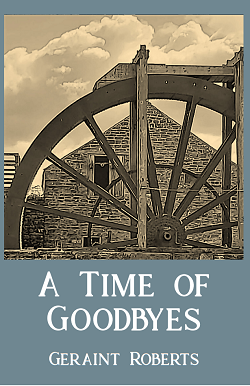The novel, ‘A Time of Goodbyes’ takes the story of Owain Thomas onwards from his young adult days in ‘The Turn of the Wheel’. The tale is of Owain and his family, amid the changing times of the late 19th Century. People in their lives come and go, as age and circumstances dictate. The story culminates a+t the beginning of ‘By the Banks of the Rheidol’.
The story however is Owain’s, so although one or two scenes may overlap with Dafydd’s tale, they are seen through the eyes of his father. It is a recognition that we all remember things slightly differently, whether it be dialogue or even actions. Yet the basics to the story reman constant.
The period of the 1880s and 1890s saw many changes to the land, and with it, to people’s lives. Mining was still a dangerous profession. Although Frongoch did not suffer the fatal accidents of the past, there were still events that would not occur in modern day mining, such was the lack of protection for the workers, the lack of civil engineering knowledge and the unfettered usage of explosives.
The worst mining for fatalities, remained coal. The problems with methane and carbon monoxide created a noxious atmosphere and over this period, there were many mass fatalities, for which there appeared little impetus from the authorities to stem. The worst was at Cilfynydd in 1894, where an explosion wiped out 290 men and 120 horses underground.
The mines around Ceredigion were far from the coalfields, due to the rocks in the area being of a much earlier age and different type. This had its problems with making the lead mines viable. The cost of transporting coal was still high, the railway having just brushed through the area en route to Aberystwyth. The Vale of Rheidol railway would not open until 1901, so horses and carts were still key, for most of the way. This was inefficient and costly, for bringing in things like coal (and for shipping out ore to harbour). Consequently, the mines still used the water of the land, giant wheels fed by miles and miles of leats and small artificial lakes.
Lead was becoming more uneconomic. The outdated working practices, tied to water power and manual labour (no electricity on site) and the distance from transport hubs had made the mines struggle. This, in the face of giant reserves being produced in Australia and the Americas. Slowly the local mines folded and miners looked for opportunities in the coalfields of the south or in the New World.
Frongoch survived, by tapping into the rising demand for zinc, with lead as a by-product. Zinc was not as profitable, but was available in greater quantities – both underground and in the waste tips, where it had been dumped in the past.
The economy suffered regularly, as competition from abroad, coupled with the development of machinery, affected employment. Workers suffered from a reduction in the need for manual labourers and from recessions. It led to a rise in disaffection and union power, as the working population tried to stand up for their rights. The worst example was at the Penrhyn slate quarry in Bethesda, where the men struck and were locked out. But in that place, there was worse to follow.
As people’s incomes fell in real terms, they questioned established practices. The giving of a tithe or tenith (a tenth of income) to the church was openly questioned. In particular, this sat badly with the rural communities in England and Wales, where nonconformism was the main branch of religion. Chapel goers found themselves paying money to a church they did not attend. It led to riots, known as the Tithe wars.
Politically there had been other awakenings. The ‘Irish question’ began to be debated, as that island strove for greater representation and home rule. This debate was nearly extended to Wales, but the moment was perhaps lost. A new Welsh-only law came into place, driven by the chapels, whereby a vote was held every seven years to decide whether alcohol would be allowed to be sold on a Sunday. This lasted until the 1980s, Ceredigion being one of the last to go ‘wet’.
Although most had been abandoned, turnpikes were finally stopped in the 1890s, the small angular booths being the only reminder of an authoritarian time for many.
Other local events included a great flood in 1886, that saw Trefechan Bridge being washed away in Aberystwyth. There was a great winter in 1890. This would have hit Frongoch hard, as it was used to regular snowfall anyway, but snow and ice will freeze the water – and so the power for the machinery. Finally, the Plynlimon and Hafan tramway opened from Llandre (Llanfihangel Geneu’r Glyn) through Talybont to the Hafan Quarry, near the modern day Nant y Moch reservoir. The tramway, designed to ship quarried stone slabs to the transport hubs, was also hoping to rejuvenate the lead mines of that valley. Sadly, by the time it had opened, they had ceased. Ironically, by the time it also succumbed, a large lead mine opened adjacent to the track-bed. Such was the fortune of the area summed up during this time.
